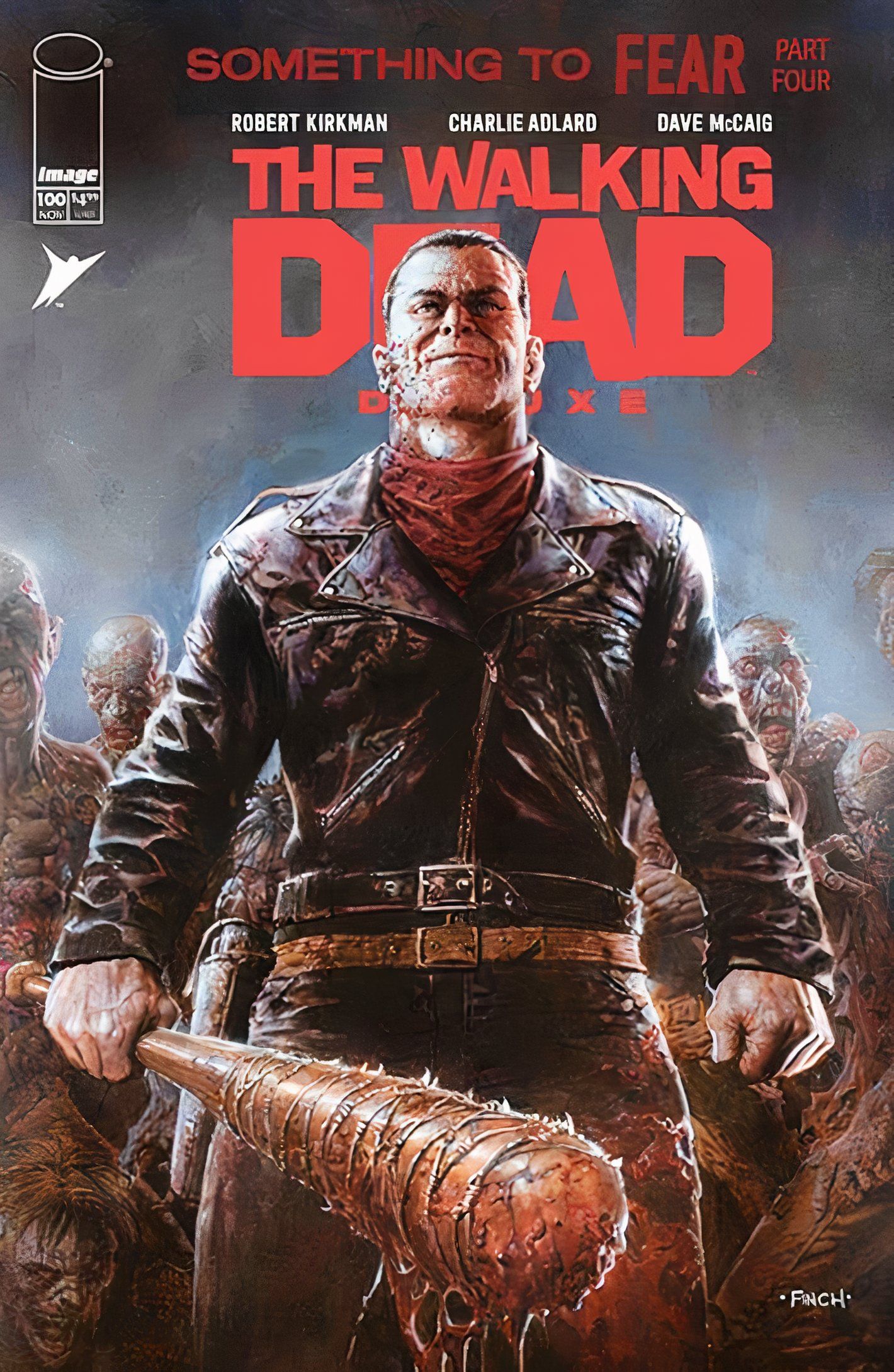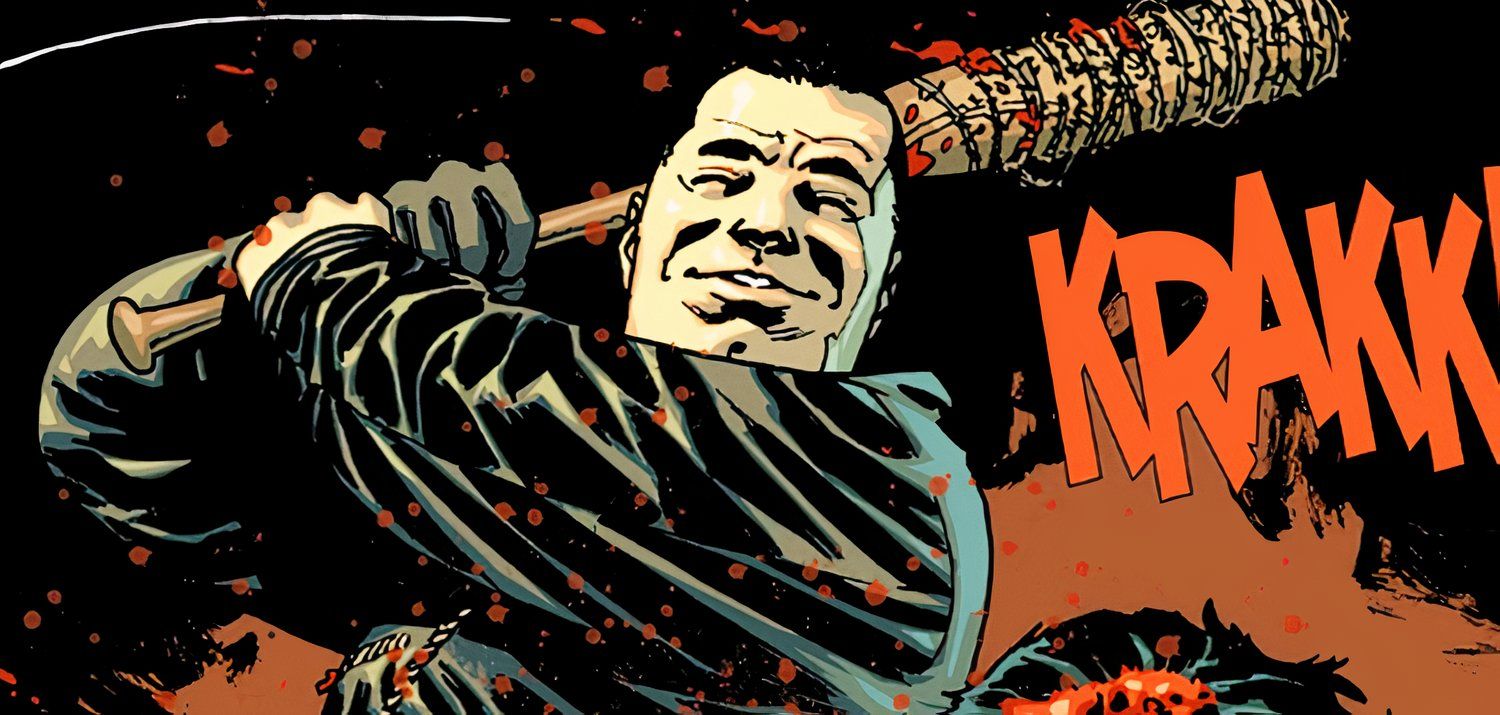
In the immediate aftermath of The Walking Dead’s most brutal scene, in which Negan infamously beat Glenn to death, Rick made a bloodthirsty vow to kill the newly-introduced villain in turn – and over a decade later, it still strikes fans as one of the comic’s greatest shocks that this promise was ultimately subverted, rather than fulfilled.
The Walking Dead Deluxe #100 – written by Robert Kirkman, with art by Charlie Adlard – is a stunning return to the milestone issue, this time in full color, making Glenn’s death that much more gutwrenching.

The issue serves as a reminder to readers how truly vile Negan was upon his first introduction. In turn, given the knowledge of how things play out, the moment where Rick Grimes tearfully declares his intention to avenge Glenn once more raises the question of whether Negan’s surprise survival and redemption arc were the right creative choice for The Walking Dead.
Rick’s Promise To Kill Negan Set Up Walking Dead’s Greatest Hero-Villain Dynamic – But The Series Never Paid It Off
The Walking Dead Deluxe #100 – Written By Robert Kirkman; Art By Charlie Adlard; Color By Dave McCaig; Lettering By Rus Wooten; Main Cover By David Finch

“I’m going to kill you,” Rick told Negan in The Walking Dead #100, setting up the dynamic between the franchise’s next great adversary and the series’ arguable protagonist. What readers who followed Robert Kirkman’s zombie comic during its original run will remember is that, at the time, there was no reason to believe that Rick would not eventually make good on this threat. By the comic’s hundredth issue, it had begun to develop a familiar rhythm – Rick and his group of survivors would encounter a malevolent group of human survivors, more dangerous than the last, and eventually, would overcome them.
In a sense, this narrative pattern applied to Negan and the Saviors, and continued even after they were defeated – except that defeat left Negan alive, and subsequent arcs transformed him into a more heroic, and even more sympathetic figure, providing the antithesis of the outcome that had been set up by his introduction. This brought an increased level of complexity to The Walking Dead’s story, and arguably it was the right choice, but it was a radical departure from the expectations author Robert Kirkman had cultivated in his audience up to that point.
How Rick Dealt With Negan Instead Of Killing Him (And Why)
The Walking Dead #125 – Written By Robert Kirkman; Art By Charlie Adlard

The battle between The Walking Dead’s main group of survivors and Negan’s Saviors lasted for twenty-five issues; it is important to note that Rick didn’t fail to kill Negan, but rather, chose not to. This was what made it such a dramatic narrative turn – and as much as many fans wanted Rick to fulfill his earlier declaration, this represented a major step forward for his character. Faced with the possibility of becoming more cruel, more like Negan, Rick refused, and that was what made it such a powerful storytelling decision.
As explained by Robert Kirkman, Walking Dead artist Charlie Adlard advocated for this twist, arguing against the trope of extracting narrative satisfaction from killing off villains. The Walking Dead was more than just zombie action entertainment – it was a meditation on human nature in the wake of civilization’s sudden collapse, and Adlard convinced Kirkman that this theme could be better explored by having Rick spare Negan, forcing him to face the consequences of his defeat, and his loss of power, rather than just being the subject of literary catharsis.
How Negan’s Survival Changed The Walking Dead Franchise
The Walking Dead Deluxe #100 – Variant Covers By Charlie Adlard & Dave McCaig; Arthur Adams & Dave McCaig; Mattia De Iulis; Yasmine Putri; Julian Totino Tedesco, & More










One unexpected byproduct of Negan’s survival, and his continued role in The Walking Dead’s story, was that the character became increasingly popular over time. Even Robert Kirkman himself admitted Negan was his favorite character by the end of the series. However, that in itself both furthered and complicated the character’s redemption arc; Kirkman, to his credit, did a solid job of having the character fit into a new role, without actually growing too much, but even so, the fact that Glenn’s murderer became a fan-favorite continues to be divisive among Walking Dead readers.
Rather than a villain to be triumphed over, Negan became one of The Walking Dead’s most recognizable characters.
While Negan’s survival made the underlying moral structure of The Walking Dead less clear-cut, it also gave fans the opportunity to root for the character’s behavior. That is to say, it contextualized his tenure as the franchise’s central bad guy as one part of a larger story arc – yet whether that was truly for the better or worse of the series overall is a question for critics to continue dissecting indefinitely. In any case, rather than a villain to be triumphed over, Negan became one of The Walking Dead’s most recognizable characters.
Glenn’s Death Remains The Gory Standard For The Walking Dead’s Most Brutal Scene
The Walking Dead #100 – First Published In 2012; Deluxe Reprint Available Now From Image Comics










Glenn’s death is widely considered the most devastating in The Walking Dead comic series. When it originally happened, it was considered a major shock, despite the fact that the book had already earned its reputation for killing off major characters without hesitation. The Deluxe reprint of The Walking Dead issues leading up to #100 has highlighted how the seeds were planted for Glenn’s demise during his final arc, and has emphasized the heartwrenching tragedy of his exit from the series.
As visceral as [Glenn’s death scene] was in black-and-white, and on screen, it has never been more gruesome than in the Deluxe edition, as this pivotal Walking Dead moment is rendered in vivid, violent color.
Hand in hand with that, The Walking Dead Deluxe #100 is a reminder of what an unrepentant, unforgivable villain Negan was upon his debut. While the shock and the gore of Glenn’s death are burnt into the memories of Walking Dead fans, what is often forgotten is the horrifying dimension that Negan’s dialogue adds to the moment. While the former were depicted faithfully on screen in the AMC TV adaptation, Jeffery Dean Morgan’s interpretation of Negan was arguably more restrained than the comic version.
While previous Walking Dead villains like the Governor had been deranged and sinister, comic book Negan was an entirely different kind of unhinged. The Walking Dead Deluxe #100 is just the start of an ongoing reappraisal of the character, as he appears in full color on the page for the first time, starting with Glenn’s death. As visceral as the scene was in black-and-white, and on screen, it has never been more gruesome than in the Deluxe edition, as this pivotal Walking Dead moment is rendered in vivid, violent color.
The Walking Dead Deluxe #100 is available now from Image Comics.





